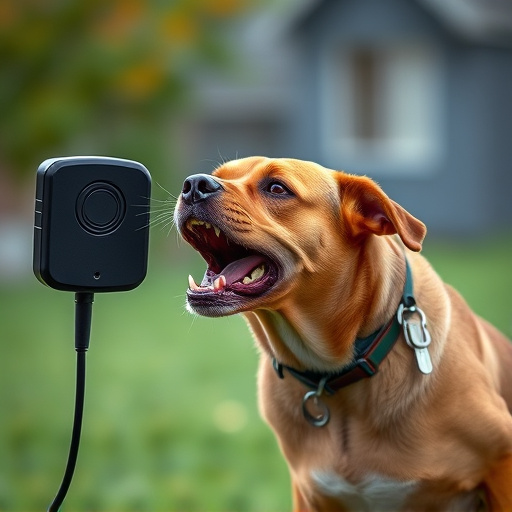Dogs have an exceptional sense of hearing, extending to ultrasonic frequencies above 20 kHz, which can be harnessed as a non-harmful method to deter unwanted behaviors like barking or aggression. Sonic dog repellers emit specific sound frequencies within the range of 3,000Hz to 15,000Hz, disrupting and discouraging canine activities without causing distress. These devices leverage the dog's sensitive hearing, with adjustable frequency settings for optimal performance in various environments.
Dogs, known for their keen senses, are highly responsive to certain sounds. This article explores a unique solution to managing canine behavior through sonic deterrents. We delve into the science behind sound as a deterrent and understand why specific frequencies hold power over dogs. By defining the effective frequency range for dogs, we guide readers in choosing the right sonic repeller. Learn how these devices work, and discover tips to ensure their effectiveness, creating a harmonious environment for both you and your furry friends.
- Understanding Dog Behavior and Their Sensitivity to Sound
- The Science Behind Sonic Deterrents: How They Work
- Defining the Effective Frequency Range for Dogs
- Choosing the Right Sonic Repeller: Tips and Considerations
Understanding Dog Behavior and Their Sensitivity to Sound
Dogs, like many mammals, have an acute sense of hearing that allows them to detect a wide range of frequencies. This sensitive auditory system plays a crucial role in their communication and survival. When it comes to understanding how to deter dogs using sound, knowing their behavior and sensory capabilities is essential.
The sonic deterrent range for dogs refers to the specific frequency levels that can capture their attention and elicit a response. Dogs are particularly receptive to high-frequency sounds, often above 20 kHz, which humans typically cannot hear. These ultrasonic frequencies can effectively startle and discourage dogs without causing them harm. By utilizing this knowledge, manufacturers have developed dog repellers that emit such sounds, creating an unpleasant experience for the canine, thereby deterring unwanted behaviors like barking or aggression.
The Science Behind Sonic Deterrents: How They Work
The Science Behind Sonic Deterrents: How They Work
Sonic deterrents for dogs operate on a principle known as acoustic repulsion. These devices emit specific sound frequencies designed to disrupt and discourage canine behavior, particularly barking or encroachment into restricted areas. The technology leverages the fact that dogs have highly sensitive hearing, far more acute than humans’. By targeting this sensory advantage, sonic deterrents create an unpleasant experience for dogs without causing them harm.
The effective frequency range of these devices plays a crucial role in their success. Different dogs may respond to varying frequencies, with most commercial models focusing on the higher end of the audible spectrum (typically between 3,000Hz to 15,000Hz). Within this range, specific tones and patterns are utilized that have been proven effective in deterring dogs without causing physical discomfort or distress. This scientific approach ensures that the deterrent remains humane while being highly effective.
Defining the Effective Frequency Range for Dogs
Dogs, much like humans, are sensitive to different sounds and frequencies. When it comes to dog repellents, understanding the sonic deterrent range is key to effective training and behavior modification. The effective frequency range for dogs typically lies between 20 Hz to 60 kHz. This range includes both low-frequency sounds that can be felt as vibrations and high-frequency sounds that are more akin to human hearing but can still cause discomfort or distress in dogs.
Within this sonic deterrent range, specific frequencies have been identified as particularly effective in encouraging positive behavior changes. For instance, ultrasonic frequencies above 25 kHz are often used in pet repellents because they are inaudible to humans but can startle and deter dogs from unwanted actions. On the other hand, lower frequencies around 20-30 Hz can mimic thunder or low rumbling sounds that dogs may associate with safety or calming signals, making them useful for desensitizing canines to loud noises or aggressive behaviors.
Choosing the Right Sonic Repeller: Tips and Considerations
When selecting a dog repeller, understanding the sonic deterrent range for dogs is key. These devices use high-frequency sound waves to create an uncomfortable sensation in canines, encouraging them to steer clear. However, not all products are created equal. Look for models that offer adjustable frequency settings, allowing you to tailor the intensity and coverage area according to your needs. This flexibility ensures maximum effectiveness in various environments, from small yards to larger properties.
Consider the specific challenges you face with dog intrusions. If you live in a dense urban area with many stray dogs, a broader frequency range might be beneficial. Conversely, if your concern is primarily with a neighbor’s dog that frequently enters your garden, a targeted, narrower range could be more suitable. Always refer to product specifications and user reviews for insights into the sonic repeller’s coverage and effectiveness.
Dogs possess a remarkable sense of hearing, making them sensitive to specific frequencies. Understanding this aspect of canine behavior is key to effectively utilizing sonic deterrents. The ideal sonic deterrent range for dogs typically falls between 25-40 kHz, as this frequency spectrum has proven effective in scaring off canines without causing harm. When selecting a dog repeller, consider factors like noise levels, coverage area, and weather resistance. By choosing the right device and placing it strategically, you can create an environment that discourages unwanted canine visitors.
